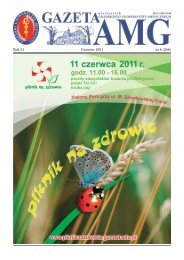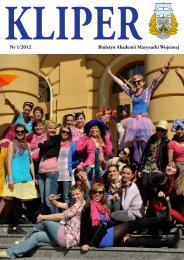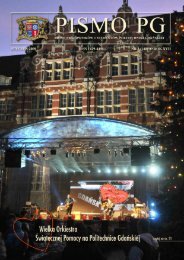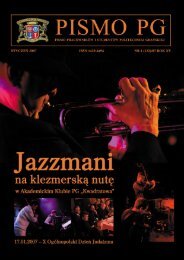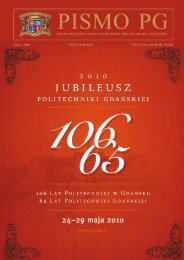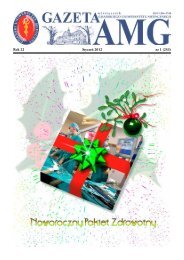- Page 2: ANNALESACADEMIAE MEDICAEGEDANENSIST
- Page 5 and 6: REDAKTOR NACZELNYPRESIDENT OF THE E
- Page 9 and 10: [5] M. Łuczkiewicz, P. Migas, A. K
- Page 11 and 12: WYKAZ NAJCZĘŚCIEJ UŻYWANYCH SKR
- Page 13: 12 Maria Łuczkiewiczin vitro rośl
- Page 18 and 19: Stanowisko w systemie oraz charakte
- Page 20 and 21: Stanowisko w systemie oraz charakte
- Page 22 and 23: Stanowisko w systemie oraz charakte
- Page 24 and 25: Stanowisko w systemie oraz charakte
- Page 26 and 27: Stanowisko w systemie oraz charakte
- Page 28 and 29: Związki flawonoidowe oraz alkaloid
- Page 30 and 31: Związki flawonoidowe oraz alkaloid
- Page 32 and 33: Biosynteza związków izoflawonoido
- Page 34 and 35: Biosynteza związków izoflawonoido
- Page 36 and 37: Biosynteza związków izoflawonoido
- Page 38 and 39: Biosynteza związków izoflawonoido
- Page 40 and 41: Biosynteza związków izoflawonoido
- Page 42 and 43: Biosynteza związków izoflawonoido
- Page 44 and 45: Biosynteza związków izoflawonoido
- Page 46 and 47: Biosynteza związków izoflawonoido
- Page 48 and 49: Badania nad izoflawonoidami w kultu
- Page 50 and 51: Badania nad izoflawonoidami w kultu
- Page 52 and 53: Badania nad izoflawonoidami w kultu
- Page 54 and 55: Badania nad izoflawonoidami w kultu
- Page 56 and 57: Badania nad izoflawonoidami w kultu
- Page 58 and 59: Badania nad izoflawonoidami w kultu
- Page 60 and 61: Badania nad izoflawonoidami w kultu
- Page 62 and 63: Badania nad izoflawonoidami w kultu
- Page 64 and 65:
Badania nad izoflawonoidami w kultu
- Page 66 and 67:
Badania nad izoflawonoidami w kultu
- Page 68 and 69:
Badania nad izoflawonoidami w kultu
- Page 70 and 71:
Badania nad izoflawonoidami w kultu
- Page 72 and 73:
Badania nad izoflawonoidami w kultu
- Page 74 and 75:
Badania nad izoflawonoidami w kultu
- Page 76 and 77:
Badania nad izoflawonoidami w kultu
- Page 78 and 79:
Aktywność farmakologiczna izoflaw
- Page 80 and 81:
Aktywność farmakologiczna izoflaw
- Page 82 and 83:
Aktywność farmakologiczna izoflaw
- Page 84 and 85:
Aktywność farmakologiczna izoflaw
- Page 86 and 87:
Aktywność farmakologiczna izoflaw
- Page 88 and 89:
Aktywność farmakologiczna izoflaw
- Page 90 and 91:
Aktywność farmakologiczna izoflaw
- Page 92 and 93:
Kultury kalusowe wybranych gatunkó
- Page 94 and 95:
Kultury kalusowe wybranych gatunkó
- Page 96 and 97:
Kultury kalusowe wybranych gatunkó
- Page 98 and 99:
Kultury kalusowe wybranych gatunkó
- Page 100 and 101:
Kultury kalusowe wybranych gatunkó
- Page 102 and 103:
Kultury kalusowe wybranych gatunkó
- Page 104 and 105:
Tab. 2. Wpływ podłoża wzrostoweg
- Page 106 and 107:
Abswzorzec wewnętrzny-izolikwiryty
- Page 108 and 109:
Kultury kalusowe wybranych gatunkó
- Page 110 and 111:
Dwufazowy system hodowlany w mikror
- Page 112 and 113:
Dwufazowy system hodowlany w mikror
- Page 114 and 115:
Dwufazowy system hodowlany w mikror
- Page 116 and 117:
Dwufazowy system hodowlany w mikror
- Page 118 and 119:
Dwufazowy system hodowlany w mikror
- Page 120 and 121:
Dwufazowy system hodowlany w mikror
- Page 122 and 123:
Tab. 4. Analiza ilościowa flawonó
- Page 124 and 125:
Dwufazowy system hodowlany w mikror
- Page 126 and 127:
Wpływ regulatorów wzrostu na akum
- Page 128 and 129:
Tab. 1. Wpływ określonych auksyn
- Page 130 and 131:
Wpływ regulatorów wzrostu na akum
- Page 132 and 133:
Wpływ regulatorów wzrostu na akum
- Page 134 and 135:
Wpływ regulatorów wzrostu na akum
- Page 136 and 137:
Wpływ regulatorów wzrostu na akum
- Page 138 and 139:
Wpływ regulatorów wzrostu na akum
- Page 140 and 141:
Wpływ regulatorów wzrostu na akum
- Page 142 and 143:
Wpływ regulatorów wzrostu na akum
- Page 144 and 145:
Wpływ regulatorów wzrostu na akum
- Page 146 and 147:
Wpływ regulatorów wzrostu na akum
- Page 148 and 149:
Wpływ regulatorów wzrostu na akum
- Page 150 and 151:
Wpływ regulatorów wzrostu na akum
- Page 152 and 153:
Wpływ regulatorów wzrostu na akum
- Page 154 and 155:
Wpływ regulatorów wzrostu na akum
- Page 156 and 157:
Wpływ regulatorów wzrostu na akum
- Page 158 and 159:
Wpływ regulatorów wzrostu na akum
- Page 160 and 161:
Wpływ morfogenezy na akumulację f
- Page 162 and 163:
Wpływ morfogenezy na akumulację f
- Page 164 and 165:
Wpływ morfogenezy na akumulację f
- Page 166 and 167:
Wpływ morfogenezy na akumulację f
- Page 168 and 169:
Wpływ morfogenezy na akumulację f
- Page 170 and 171:
Wpływ morfogenezy na akumulację f
- Page 172 and 173:
Wpływ morfogenezy na akumulację f
- Page 174 and 175:
Wpływ morfogenezy na akumulację f
- Page 176 and 177:
Tab. 1. Zawartość izoflawonów w
- Page 178 and 179:
Tab. 3. Zawartość izoflawonów w
- Page 180 and 181:
Wpływ morfogenezy na akumulację f
- Page 182 and 183:
Wpływ elicytacji oraz permeabiliza
- Page 184 and 185:
Wpływ elicytacji oraz permeabiliza
- Page 186 and 187:
Wpływ elicytacji oraz permeabiliza
- Page 188 and 189:
Wpływ elicytacji oraz permeabiliza
- Page 190 and 191:
Wpływ elicytacji oraz permeabiliza
- Page 192 and 193:
Wpływ elicytacji oraz permeabiliza
- Page 194 and 195:
Tab. 2. Zawartość izoflawonów w
- Page 196 and 197:
Tab. 4. Zawartość izoflawonów w
- Page 198 and 199:
Tab. 6. Zawartość izoflawonów w
- Page 200 and 201:
Tab. 8. Zawartość izoflawonów w
- Page 202 and 203:
454035• DW podstawowa• DW kwas
- Page 204 and 205:
200180-•—hodowla podstawowa-O
- Page 206 and 207:
800700i—i50456006-40500—0— FW
- Page 208 and 209:
1000090008000• hodowla podstawowa
- Page 210 and 211:
9080sam•sehcusgo"Bka70605040—
- Page 212 and 213:
Wpływ elicytacji oraz permeabiliza
- Page 214 and 215:
Korzenie włośnikowate G. tinctori
- Page 216 and 217:
Korzenie włośnikowate G. tinctori
- Page 218 and 219:
Korzenie włośnikowate G. tinctori
- Page 220 and 221:
Korzenie włośnikowate G. tinctori
- Page 222 and 223:
Korzenie włośnikowate G. tinctori
- Page 224 and 225:
Korzenie włośnikowate G. tinctori
- Page 226 and 227:
Korzenie włośnikowate G. tinctori
- Page 228 and 229:
Korzenie włośnikowate G. tinctori
- Page 230 and 231:
Korzenie włośnikowate G. tinctori
- Page 232 and 233:
Korzenie włośnikowate G. tinctori
- Page 234 and 235:
Korzenie włośnikowate G. tinctori
- Page 236 and 237:
Korzenie włośnikowate G. tinctori
- Page 238 and 239:
Kokultury korzeni włośnikowatych
- Page 240 and 241:
Kokultury korzeni włośnikowatych
- Page 242 and 243:
Kokultury korzeni włośnikowatych
- Page 244 and 245:
Kokultury korzeni włośnikowatych
- Page 246 and 247:
\~-l „+ ,1- ADAKokultury korzeni
- Page 248 and 249:
Kokultury korzeni włośnikowatych
- Page 250 and 251:
Kokultury korzeni włośnikowatych
- Page 252 and 253:
Kokultury korzeni włośnikowatych
- Page 254 and 255:
Kokultury korzeni włośnikowatych
- Page 256 and 257:
Kokultury korzeni włośnikowatych
- Page 258 and 259:
Tab. 1. Zawartość izoflawonów w
- Page 260 and 261:
Kokultury korzeni włośnikowatych
- Page 262 and 263:
LC-DAD UV i LC-MS w analizie izofla
- Page 264 and 265:
LC-DAD UV i LC-MS w analizie izofla
- Page 266 and 267:
LC-DAD UV i LC-MS w analizie izofla
- Page 268 and 269:
LC-DAD UV i LC-MS w analizie izofla
- Page 270 and 271:
LC-DAD UV i LC-MS w analizie izofla
- Page 272 and 273:
LC-DAD UV i LC-MS w analizie izofla
- Page 274 and 275:
Abs 5 6 7i10wzorzec wewnętrzny - i
- Page 276 and 277:
Ryc. 4. Chromatogram HPLC frakcji f
- Page 278 and 279:
malonyl-glu-O vOmalonylogenistynaOH
- Page 280 and 281:
HOOH4',7-dihydroksyizoflawanI i j .
- Page 282 and 283:
LC-DAD UV i LC-MS w analizie izofla
- Page 284 and 285:
LC-DAD UV i LC-MS w analizie izofla
- Page 286 and 287:
Analiza chromatograficzna - TLC alk
- Page 288 and 289:
Analiza chromatograficzna - TLC alk
- Page 290 and 291:
Analiza chromatograficzna - TLC alk
- Page 292 and 293:
Analiza chromatograficzna - TLC alk
- Page 294 and 295:
Analiza chromatograficzna - TLC alk
- Page 296 and 297:
Analiza chromatograficzna - TLC alk
- Page 298 and 299:
Analiza chromatograficzna - TLC alk
- Page 300 and 301:
1,001+2+7+8+90,900,803+6c2'UO1-0,70
- Page 302 and 303:
1,000,900,800,70 -\Xspartein e a (8
- Page 304 and 305:
Analiza chromatograficzna - TLC alk
- Page 306 and 307:
Analiza chromatograficzna - TLC alk
- Page 308 and 309:
Streszczenie 307Z uwagi na całkowi
- Page 310 and 311:
Streszczenie 309złożoną z: chlor
- Page 312 and 313:
Streszczenie 311kultur badanych jan
- Page 314 and 315:
Streszczenie 313w niskich stężeni
- Page 316 and 317:
Streszczenie 315w szlaku metabolicz
- Page 318 and 319:
Streszczenie 317Transgeniczny chara
- Page 320 and 321:
Streszczenie 319równolegle przebie
- Page 322 and 323:
Summary 321(Gamborg, Nitsch and Nit
- Page 324 and 325:
Summary 323from the plant matrix wi
- Page 326 and 327:
Summary 325apigenin. It should be n
- Page 328 and 329:
Summary 327and in this way, higher
- Page 330 and 331:
Summary 329mg/100 g dry weight). Th
- Page 332 and 333:
Summary 331quantities of the direct
- Page 334 and 335:
Wyniki i wnioski 33317. WYNIKI I WN
- Page 336 and 337:
Wyniki i wnioski 33512. W toku prze
- Page 338 and 339:
Wyniki i wnioski 337z powyższym mo
- Page 340 and 341:
Wyniki i wnioski 33939. W efekcie p
- Page 342 and 343:
Wyniki i wnioski 34111. Zoptymalizo





